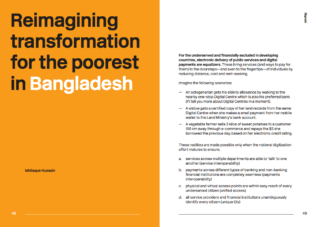
For the underserved and financially excluded in developing countries, electronic delivery of public services and digital payments are equalisers. These bring services (and ways to pay for them) to the doorsteps – and even to the fingertips – of individuals by reducing distance, cost and rent-seeking.
Imagine the following scenarios:
- An octogenarian gets his elderly allowance by walking to the nearby one-stop Digital Centre which is also his preferred bank (I’ll tell you more about Digital Centres in a moment).
- A widow gets a certified copy of her land records from the same Digital Centre when she makes a small payment from her mobile wallet to the Land Ministry’s bank account.
- A vegetable farmer sells 3 kilos of sweet potatoes to a customer 100 km away through e-commerce and repays the $5 she borrowed the previous day, based on her electronic credit rating.
These realities are made possible only when the national digitization effort matures to ensure:
- services across multiple departments are able to ‘talk’ to one another (service interoperability)
- payments across different types of banking and non-banking financial institutions are completely seamless (payments interoperability)
- physical and virtual access points are within easy reach of every underserved citizen (unified access)
- all service providers and financial institutions unambiguously identify every citizen (unique IDs)
In Bangladesh, government agencies have worked together to build the country’s own version of an integrated ‘stack’ of digital ID, services, and payment platforms. Together, these have already saved citizens of Bangladesh more than USD 8 billion over the last 10 years because of the creation of over 200 services which have drastically reduced the time, cost and number of visits required to access public services.
Combined with a ‘Unified Payments Interface’ (UPI), these platforms have the potential to enable the government to offer new kinds of digital financial services. Interoperability is crucial: as already demonstrated in India, thanks to interoperability, more financial transactions took place using UPI in 18 months than on credit cards in 18 years.
Building stacks of interconnectivity
We describe these interconnecting technologies as a “stack”. We can only put citizens’ needs first when the stack is designed and built with interoperable pieces.
In Bangladesh, we have found it helpful to build a central platform to make interoperability easier. It’s known as the Integrated Service Delivery Platform (ISDP) and it makes it simpler to design public facing services that are orientated around the needs of citizens, rather than the organizational structure of government.
But the stack isn’t just about the technology: it’s also about the delivery.
Digital Centres for citizen-centric services
Digital services are no good if people cannot access them. To ensure we reach the most underserved and most marginalized people, we have made services accessible across a variety of channels.
One of these is a network of over 5,500 Digital Centres. Each is run by a local citizen entrepreneur, and provides connectivity and information services at the doorsteps of rural people. There is now a Digital Centre within 4km of every citizen in Bangladesh.
Each Centre provides human help. People with poor literacy, or who have never used the web or an app before, are able to get step-by-step assistance from the Centre’s staff.
Citizens don’t have to go to a Digital Centre. The same services are available on the web, via smartphones, and a call centre. Citizens have the option to use any means they prefer and find most convenient.
There’s still a lot to learn
Getting to this point required a lot of hard work. We needed to find answers to a lot of questions. We’re still finding some of those answers now. Some of the key questions we’re exploring are:
- How do we shift mindsets from product to platform thinking?
- Where do we find private sector partners who understand platforms? How do we develop the expertise rapidly? (Open source expertise is rare in Bangladesh.)
- What procurement reform do we need to open up development of the platforms to the private sector?
- Who drives the implementation of the platforms and who finally owns them?
- Who owns the data? How do we separate data of platforms and data of products built on platforms?
- How do we create a business model for the platforms?
We hope the answers to these questions will help government, the private sector, and others to deliver radically better services. And do so in a way that makes it simpler and faster for both civil servants, the private sector and non-profits, to meet citizens’ needs.
However, increased efficiency is not the most significant opportunity arising from reimagining government as a platform. The biggest opportunity is that services do not just become simpler and quicker to design, but that it also becomes simpler to design new types of services.
For example, someone wanting to start a company in Bangladesh today may need to secure a trade license from one government agency, apply for employer’s certification with another, for tax purposes with yet another, then apply for different licences from central and local governments, and so on. In other words, the organizational structure of bureaucracies dictates service delivery processes.
We believe that the ISDP could change this. That’s because it makes it simpler to design public-facing services that are orientated around the needs of citizens rather than the organizational structure of government.